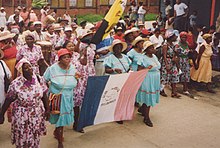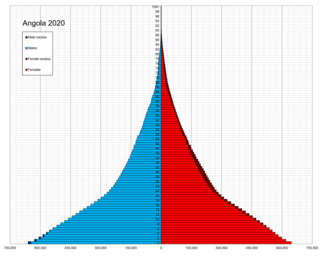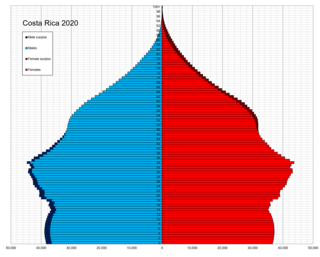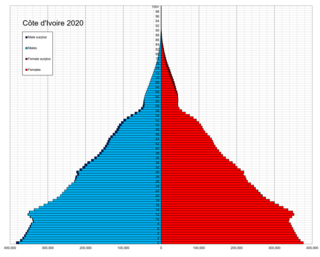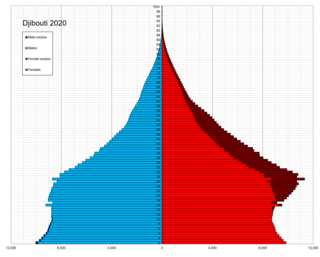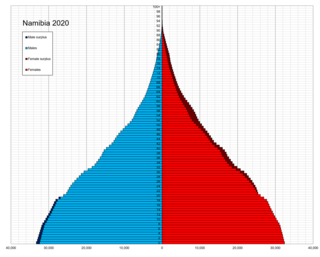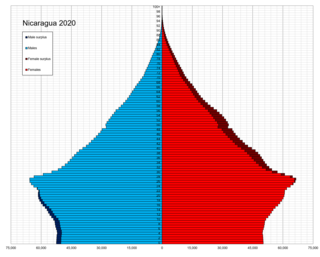| Demographics of Guatemala | |
|---|---|
 Population pyramid of Guatemala in 2020 | |
| Population | 17,703,190 (2022 est.) |
| Growth rate | 1.58% (2022 est.) |
| Birth rate | 22.34 births/1,000 population (2022 est.) |
| Death rate | 4.91 deaths/1,000 population (2022 est.) |
| Life expectancy | 72.91 years |
| • male | 70.88 years |
| • female | 75.04 years |
| Fertility rate | 2.62 children born/woman (2022 est.) |
| Infant mortality rate | 26.18 deaths/1,000 live births |
| Net migration rate | -1.66 migrant(s)/1,000 population (2022 est.) |
| Age structure | |
| 0–14 years | 32.74% |
| 15–64 years | 61.95% |
| 65 and over | 5.31% |
| Sex ratio | |
| Total | 0.98 male(s)/female (2022 est.) |
| At birth | 1.05 male(s)/female |
| Under 15 | 1.04 male(s)/female |
| 65 and over | 0.68 male(s)/female |
| Nationality | |
| Nationality | Guatemalan |
| Language | |
| Official | Spanish |
This is a demography of the population of Guatemala including population density, ethnicity, education level, health of the populace, economic status, religious affiliations and other aspects of the population.
Contents
- Population
- Population by departments
- Emigration
- Ethnic groups
- Vital statistics
- UN estimates
- Vital statistics 2
- Current vital statistics
- Fertility and births (demographic and health surveys)
- Structure of the population
- Marriage and childbearing
- Other demographic statistics
- Population 2
- Ethnic groups 2
- Age structure
- Birth rate
- Death rate
- Total fertility rate
- Median age
- Population growth rate
- Net migration rate
- Mother's mean age at first birth
- Contraceptive prevalence rate
- Dependency ratios
- Life expectancy at birth
- Major infectious diseases
- Languages
- Religions
- Urbanization
- Education expenditures
- Literacy
- School life expectancy (primary to tertiary education)
- Unemployment, youth ages 15–24
- Languages 2
- Religion
- References
According to the 2018 census, 43.56% of the population is Indigenous including 41.66% Mayan, 1.77% Xinca, and 0.13% Garifuna (Mixed African and indigenous). [1] Approximately 56% of the population is "non-Indigenous", [1] referring to the Mestizo population (people of mixed European and indigenous descent) and the people of European origin. These people are called Ladino in Guatemala. The population is divided almost evenly between rural and urban areas. [2]
About 65% of the population speak Spanish, with nearly all the rest speaking indigenous languages (there are 23 officially recognized indigenous languages). [3]
| Year | Pop. | ±% |
|---|---|---|
| 1778 | 396,149 | — |
| 1880 | 1,224,602 | +209.1% |
| 1893 | 1,364,678 | +11.4% |
| 1921 | 2,004,900 | +46.9% |
| 1940 | 2,400,000 | +19.7% |
| 1950 | 2,790,868 | +16.3% |
| 1964 | 4,287,997 | +53.6% |
| 1973 | 5,160,221 | +20.3% |
| 1981 | 6,054,227 | +17.3% |
| 1994 | 8,331,874 | +37.6% |
| 2002 | 11,237,196 | +34.9% |
| 2018 | 14,901,286 | +32.6% |
| Source: [4] [5] | ||

